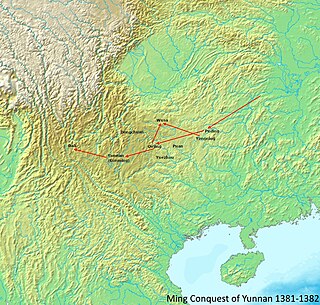Related Research Articles

While there are many historical and modern schools of Taoism with different teachings on the subject, many Taoist priests regard their diet as extremely important to their physical, mental and spiritual health in one way or another, especially where the amount of qi in the food is concerned.

Mount Qingcheng is a sacred Taoist mountain in Dujiangyan, Chengdu, Sichuan, China.

Hu Dahai, courtesy name Tongfu (通甫), was a Chinese Muslim and military general who lived in the 14th century. He is best known for helping Zhu Yuanzhang establish the Ming dynasty in China.
The 1642 Yellow River flood or Kaifeng flood was a man-made disaster in October, 1642, that principally affected Kaifeng and Xuzhou.

Wang Zhen was the first Ming dynasty eunuch with power in the court. He served Zhu Qizhen who promoted him to become 'one of the most powerful eunuch "dictators" in Ming history'.
Yishiha was a Jurchen eunuch of the Ming dynasty of China. He served the Ming emperors who commissioned several expeditions down the Songhua and Amur Rivers during the period of Ming rule of Manchuria, and is credited with the construction of the only two Ming dynasty Buddhist temples ever built on the territory of present-day Russia.
Nguyễn An, known in Chinese as Ruan An (pinyin) or Juan An (Wade-Giles), was a Ming dynasty architect and hydraulics specialist between the first and fifth decades of the 15th century. According to some sources, he was a key architect in designing, planning and constructing of the Forbidden City during the Ming dynasty. Born in Vietnam, he was taken as tribute to China and later became a eunuch and architect in service to the Chinese emperors. He, along with other architects, such as master designers and planners Cai Xin (蔡信), Kuai Xiang (蒯祥), Chen Gui (陳珪), and Wu Zhong (吳中), was a builder of the Forbidden City in Beijing.
Wang Jinghong was a Ming dynasty Chinese mariner, explorer, diplomat and fleet admiral, who was deputy to Zheng He on his treasure voyages to Southeast Asia, South Asia, and East Africa, from 1405 to 1433. He led an eighth voyage to Sumatra but is said to have died in a shipwreck on the way. He was buried at Semarang in Java aged 78.

The Ming conquest of Yunnan was the final phase in the Ming dynasty expulsion of Mongol-led Yuan dynasty rule from China proper in the 1380s.
The 1375 Yellow River flood was a natural disaster affecting the area around Kaifeng, China during the early Ming dynasty. Contemporary sources mentioned a death toll of between 15,000 and 25,000 people, most of them farmers. The philosopher Wang Yangming mentioned the 1375 Yellow River flood as an example of how even a virtuous man can be destroyed by the power of nature.
The 1384 Yellow River flood was a natural disaster affecting the area around Kaifeng, China, during the early Ming dynasty.
The 1410 Yellow River flood was a natural disaster affecting the area around Kaifeng, China, during the early Ming dynasty.
The 1416 Yellow River flood was a natural disaster affecting the area around Kaifeng, China, during the early Ming dynasty. The flood spilled over into fourteen other counties and seriously disturbed the Huai River.
The 1441 Yangtze flood was a natural disaster affecting the area around Nanjing, China, during the Ming dynasty.
The 1391 Yellow River flood was a major natural disaster during the early Ming dynasty in China.
The 1448 Yellow River flood was a major natural disaster affecting over 2000 li of the Yellow River. The flood threatened to destroy the Grand Canal port of Linqing and led to the Ming dynasty constructing major public works in Shawan to prevent a recurrence. The banks and dikes only lasted four years until the 1452 flood.
The 1453 Yellow River flood was a natural disaster in the area surrounding Shawan in Shandong, China, during the Ming dynasty. The banks – repaired just the year before – burst again in the fourth lunar month and again in the fifth.

The 1494 Yellow River flood was a natural disaster in China during the Ming dynasty.
Eastern Depot or Eastern Bureau was a Ming dynasty spy and secret police agency run by eunuchs. It was created by the Yongle Emperor.
Yanguang Niangniang is a Taoist goddess of eyesight and vision. She was one of the popular Taoist goddesses in China during the Ming and Qing dynasties. She is believed to cure blindness and other ailments related to vision. In Daoist paintings or sculptures, she is often seen accompanying Bixia Yuanjun among other attendant goddesses.
References
- ↑ Tsai, Shih-Shan Henry.SUNY Series in Chinese Local Studies: The Eunuchs in the Ming Dynasty . SUNY Press, 1996. ISBN 0791426874, 9780791426876. Accessed 16 Oct 2012.